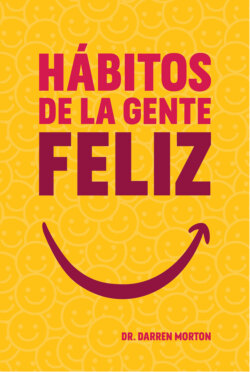Читать книгу Hábitos de la gente feliz - Darren Morton - Страница 13
¿Quieres tu Limbo en buena forma?
ОглавлениеHemos visto que el Limbo desempeña diversas funciones y propicia estados importantes: felicidad, memoria, motivación y muchos procesos corporales automáticos.
Así que, ¿cómo podemos hacer que nuestro Limbo funcione de la mejor manera?
Aquí viene la parte más emocionante.
Al igual que los gatos que llegaron a ser amigables o feroces simplemente al estimular su Limbo de la manera adecuada, podemos presionar los botones para estimular nuestro Limbo para bien o para mal y, al hacerlo, cambiar la forma en que nos sentimos.
¡Así que, aprendamos cómo estimular nuestro Limbo para sentirnos bien!
11 P. MacLean y J. Delgado, “Electrical and chemical stimulation of the fronto-temporal portion of the limbic system in the waking animal”, Electroencephalograph Clinical Neurophysiology, 5:1 (1953), pp. 91-100.
12 J. Olds y P. Milner, “Positive reinforcement produced by electrical stimulation of septal area and other regions of rat brain”, Journal of Comparative and Physiological Psychology, 47 (1954), pp. 419-427.
13 D. L. Clark, N. N. Boutros y M. F. Mendez, The Brain and Behavior: An Introduction to Behavioral Neuroanatomy (Cambridge Press, 2010).
14 W. C. Drevets, L. Joseph, J. L. Price y M. L. Furey, “Brain structural and functional abnormalities in mood disorders: Implications for neurocircuitry models of depression”, Brain Structure and Function, 213 (2008), pp. 93-118.
15 Clark y otros, The Brain and Behavior.
16 D. D. Danner, D. A. Snowdon y W. V. Friesen, “Positive Emotions in Early Life and Longevity: Findings from the Nun Study”, Journal of Personality and Social Psychology, 80:5 (2001), pp. 804-813.
17 E. Diener y M. Y. Chan, “Happy People Live Longer: Subjective Well-Being Contributes to Health and Longevity”, Applied Psychology: Health and Well-being, 3:1 (2011), pp. 1-43.
18 S. Pressman y D. Cohen, “Positive Emotion Word Use and Longevity in Famous Deceased Psychologists”, Health Psychology 31:3 (2012), pp. 297-305.
19 B. R. Levy, M. D. Slade, S. R. Kunkel y S. V. Kasl, “Longevity Increased by Positive Self-Perceptions of Aging”, Journal of Personality and Social Psychology, 83:2 (2002), pp. 261-270.
20 E. Abel y M. Kruger, “Smile Intensity in Photographs Predicts Longevity”, Psychological Science, 21:4 (2010), pp. 542-544.
21 G. Fraser y D. Shavlik, “Ten years of life. Is it a matter of choice?”, Archive of Internal Medicine, 161 (2001), pp. 1.645-1.652.
22 Diener y Chan, “Happy People Live Longer”.
23 Traducción libre de la versión en inglés Good News Bible.
24 L. Harker y D. Keltner, “Expressions of Positive Emotion in Women’s College Yearbook Pictures and Their Relationship to Personality and Life Outcomes Across Adulthood”, Journal of Personality and Social Psychology, 80:1 (2001), pp. 112-124.
25 I. Roberston y C. Cooper, Well-being: Productivity and happiness at work (Palgrave Macmillan, 2011).
26 J. K. Boehm y S. Lyubomirsky, “Does Happiness Promote Career Success?”, Journal of Career Assessment, 16:1 (2008), pp. 101-116; E. Diener y R. Biswas-Diener, Happiness: Unlocking the Mysteries of Psychological Wealth (Blackwell Publishing, 2008).
27 Diener y Chan, “Happy People Live Longer”.
28 K. Patterson, J. Grenny, D. Maxfield, R. McMillan y A. Switzler, Change Anything: The New Science of Personal Success (Piatkus, 2011).
29 J. E. Williams, C. C. Paton, I. C. Siefler, M. L. Eigenbrodt, F. J. Nieto y H. A. Tyroler, “Anger Proneness Predicts Coronary Heart Disease Risk: Prospective Analysis From the Atherosclerosis Risk In Communities (ARIC) Study”, Circulation, 101 (2000), pp. 2.034-2.039.
30 A. Peters, S. von Klot, M. Heier, I. Trentinaglia, A. Hormann, H. E. Wichmann y H. Lowel, “Exposure to Traffic and the Onset of Myocardial Infarction”, New England Journal of Medicine, 351:17 (2004), pp. 1.721-1.730.
31 J. K. Boehm y L. D. Kubzansky, “The Heart’s Content: The Association Between Positive Psychological Weil-Being and Cardiovascular Health”, Psychological Bulletin, 138:4 (2012), pp. 655-691.
32 E. Mayer, “Gut feelings: the emerging biology of gut-brain communication”, (2011), 12, pp. 453-466.
33 J. K. Kiecolt-Glaser, T. J. Loving, J. R. Stowell, W. B. Malarkey, S. Lemeshow, S. L. Dickinson y R. Glaser, “Hostile marital interactions, proinflammatory cytokine production, and wound healing”, Archives of General Psychiatry, 62 (2005), pp. 1.377-1.384.
34 P. T. Marucha, J. K. Kiecolt-Glaser y M. Favagehi, “Mucosal wound healing is impaired by examination stress”, Psychosomatic Medicine, 60 (1998), pp. 362-365.
